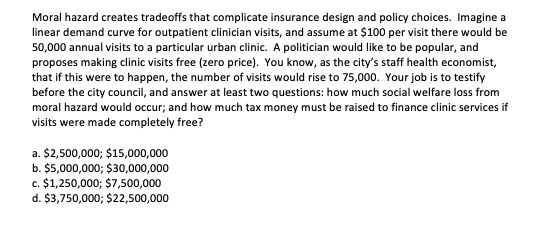Moral hazard creates tradeoffs that complicate insurance design and policy choices. Imagine a linear demand curve for outpatient clinician visits, and assume at $100 per visit there would be 50,000 annual visits to a particular urban clinic. A politician would like to be popular, and proposes making clinic visits free (zero price). You know, as the city's staff health economist, that if this were to happen, the number of visits would rise to 75,000. Your job is to testify before the city council, and answer at least two questions: how much social welfare loss from moral hazard would occur; and how much tax money must be raised to finance clinic services if visits were made completely free? a. $2,500,000; $15,000,000 b. $5,000,000; $30,000,000 c. $1,250,000; $7,500,000 d. $3,750,000; $22,500,000
Moral hazard creates tradeoffs that complicate insurance design and policy choices. Imagine a linear demand curve for outpatient clinician visits, and assume at $100 per visit there would be 50,000 annual visits to a particular urban clinic. A politician would like to be popular, and proposes making clinic visits free (zero price). You know, as the city's staff health economist, that if this were to happen, the number of visits would rise to 75,000. Your job is to testify before the city council, and answer at least two questions: how much social welfare loss from moral hazard would occur; and how much tax money must be raised to finance clinic services if visits were made completely free? a. $2,500,000; $15,000,000 b. $5,000,000; $30,000,000 c. $1,250,000; $7,500,000 d. $3,750,000; $22,500,000
Chapter12: Medicare
Section: Chapter Questions
Problem 4QAP
Related questions
Question

Transcribed Image Text:Moral hazard creates tradeoffs that complicate insurance design and policy choices. Imagine a
linear demand curve for outpatient clinician visits, and assume at $100 per visit there would be
50,000 annual visits to a particular urban clinic. A politician would like to be popular, and
proposes making clinic visits free (zero price). You know, as the city's staff health economist,
that if this were to happen, the number of visits would rise to 75,000. Your job is to testify
before the city council, and answer at least two questions: how much social welfare loss from
moral hazard would occur; and how much tax money must be raised to finance clinic services if
visits were made completely free?
a. $2,500,000; $15,000,000
b. $5,000,000; $30,000,000
c. $1,250,000; $7,500,000
d. $3,750,000; $22,500,000
Expert Solution
This question has been solved!
Explore an expertly crafted, step-by-step solution for a thorough understanding of key concepts.
This is a popular solution!
Trending now
This is a popular solution!
Step by step
Solved in 3 steps

Recommended textbooks for you


Economics (MindTap Course List)
Economics
ISBN:
9781337617383
Author:
Roger A. Arnold
Publisher:
Cengage Learning



Economics (MindTap Course List)
Economics
ISBN:
9781337617383
Author:
Roger A. Arnold
Publisher:
Cengage Learning



Exploring Economics
Economics
ISBN:
9781544336329
Author:
Robert L. Sexton
Publisher:
SAGE Publications, Inc